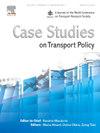Examining network governance of multimodal integration: A comparative study of rural mobility hubs in The Netherlands
IF 3.3
Q3 TRANSPORTATION
引用次数: 0
Abstract
Sufficient accessibility ensures that rural populations can participate in transport societal processes. However, linear public systems often fall short in these areas due to inefficiencies such as indirect routing, low frequencies, and limited stops. Integrating functionally interdependent transport networks across spatial scales inevitably increases institutional interdependencies and complexity. This paper examines the governance of multimodal integration by combining functionally interrelated transport services into an institutional ‘network-of-networks’ for two case studies in the Netherlands: Groningen-Drenthe and Zeeland. The findings show that central coordination mainly occurs through information and organisation instruments, cliques of actors form around individual transport modes, and the mode of governance depends on network maturity and scope. In this context, barriers of ambiguous responsibility, patchworked policy instruments, and interoperability gaps between transport services affect the network’s ability to achieve positive accessibility and efficiency effects. Future governance designs could balance central coordination to ensure consistent modal availability with decentralised coordination to facilitate bottom-up initiatives. Additionally, implementing instruments that create overlap between mode-specific network cliques may further encourage interoperability.
考察多模式整合的网络治理:荷兰农村交通枢纽的比较研究
充分的可达性确保农村人口能够参与运输社会进程。然而,由于效率低下,如间接路线、低频率和有限的停站,线性公共系统往往在这些地区不足。跨空间尺度整合功能上相互依赖的交通网络,不可避免地增加了制度上的相互依赖和复杂性。本文对荷兰格罗宁根-德伦特和泽兰的两个案例进行了研究,通过将功能相关的运输服务结合到一个制度性的“网络的网络”中,研究了多式联运一体化的治理。研究结果表明,中央协调主要通过信息和组织手段实现,行为体围绕个体运输方式形成集团,治理模式取决于网络的成熟度和范围。在这种情况下,责任模糊的障碍、拼凑的政策工具和运输服务之间的互操作性差距影响了网络实现积极的可达性和效率效应的能力。未来的治理设计可以平衡中央协调以确保一致的模式可用性和分散协调以促进自下而上的计划。此外,实现在特定模式的网络集团之间创建重叠的工具可能进一步鼓励互操作性。
本文章由计算机程序翻译,如有差异,请以英文原文为准。
求助全文
约1分钟内获得全文
求助全文

 求助内容:
求助内容: 应助结果提醒方式:
应助结果提醒方式:


